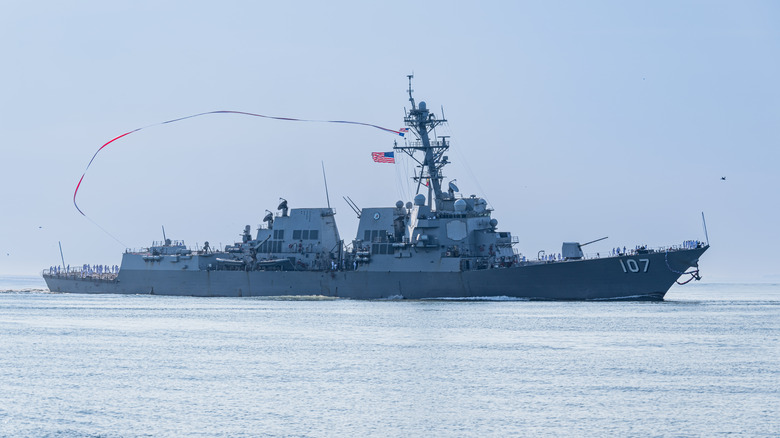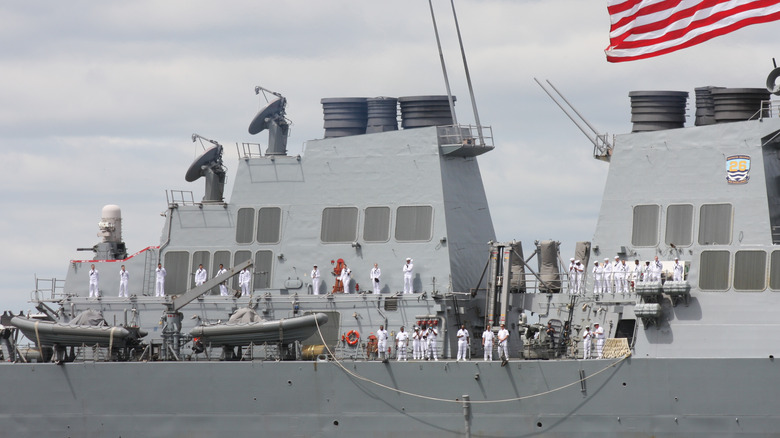How Big Is The Crew On A US Destroyer Ship?
Throughout its history, the destroyer has been one of the most important and powerful vessels in the United States Navy fleet. Primarily tasked with ship escort and fleet protection roles, a destroyer is also capable of conducting anti-aircraft and anti-submarine operations. For the American military, there are currently two different classes of destroyers serving in its naval force: the Arleigh Burke-class and the Zumwalt-class, both of which are considered some of the most powerful destroyers in the world. To operate these formidable ships, the Arleigh Burke class has a crew of between 303 and 323, depending on the variant, while the Zumwalt has 158 sailors.
Commissioned in 1991, the Arleigh Burke class is one of the modern destroyers of the American Navy and was created to succeed the Charles F. Adams class. More advanced than its predecessor, the Arleigh Burke class is equipped with the latest technologies in communications, electronic warfare, and weaponry. Designed to be stealthy and now armed with the latest in missile technology, the Zumwalt-class destroyer was a product of the Naval DD(X) program of the 1990s and was commissioned in 2016.
Both destroyer classes need a lot of manpower due to the different intricate systems required to operate the ship. In the case of the Arleigh Burke class, its crew organization is divided into several levels, including enlisted officers and personnel, who are responsible for the administration, and management of the various ship departments, including operations that cover navigation and communications, supply, deck, engineering that involve propulsion and electricals, combat systems, and other departments. The number of crew assigned per department varies and is based on its function; for example, the weapons department alone has 65 petty officers and five chiefs.
Enough crew to man and operate a complex ship
Additionally, destroyers like the Arleigh Burke class also require a sizable crew because they operate on a 24-hour, seven-day week, the whole year-round. This means that the crew is divided into shifts called watches, which can be between four and eight hours. Lastly, the crew size also serves as a contingency measure in the event of a system breaking down or when a crew member falls ill and cannot go on duty. While considerable, the crew numbers on a U.S. destroyer is small, compared to the 4,600 that the USS Gerald R. Ford, the world's most powerful warship, can accommodate.
The navies of other countries also field destroyers with a similar crew size. The Republic of South Korea's Sejong Daewang-class is an Aegis-equipped destroyer built by Hyundai Heavy Industries, which went into service in 2008. It's manned by between 300 and 400 sailors. Another destroyer with a sizeable crew count is the Kongo-class destroyers from Japan. Designed and built in the 1990s to provide front-line air defense capabilities of the Japan Maritime Self-Defense Force, the Kongo-class is a modern vessel and is also outfitted with the Aegis missile system. The ship has a crew of around 300 personnel.
From the USS Bainbridge, the first U.S. destroyer, which was crewed by just 72 sailors, to the hundreds that operate its descendant, the Arleigh Burke, destroyers have evolved to meet the changing needs of naval warfare. Since its inception, destroyers have served in numerous roles and continue to be the cornerstone of naval operations. While ships are currently manpower intensive, the autonomous drone prototype, USX-1 Defiant, could change all that, hinting at a future where naval vessels don't need humans on board at all.

